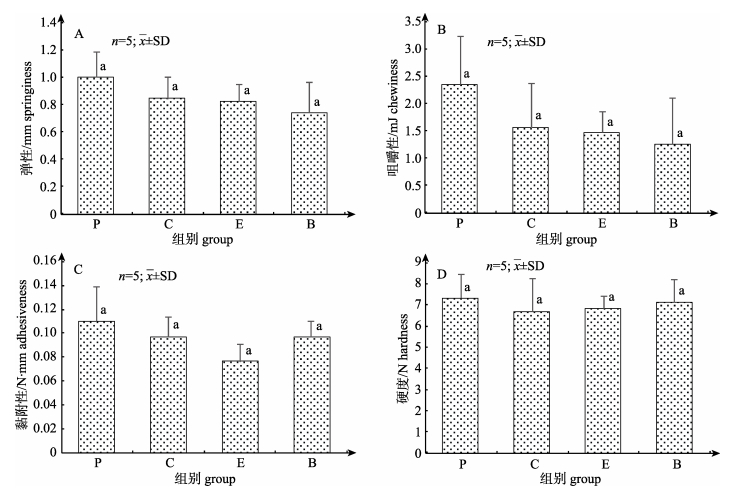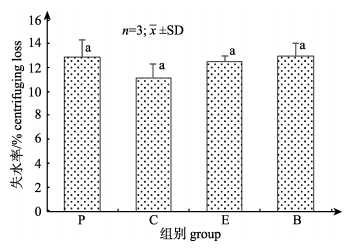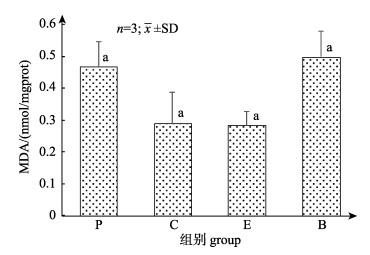2. 青岛农业大学海都学院, 山东 烟台 265100;
3. 青岛根源生物技术集团有限公司, 山东 青岛 266000
2. Haidu College, Qingdao Agricultural University, Yantai 265100, China;
3. Qingdao Genyuan Biotech Group, Qingdao 266000, China
凡纳滨对虾(Litopenaeus vannamei), 又称南美白对虾、白对虾, 因其高产量、广盐性以及鲜美的肉质与高营养价值被广泛养殖, 是当今世界养殖产量最高的三大优良虾种之一。自中国科学院海洋研究所1988年首次引进凡纳滨对虾以来, 其养殖产量急剧增长, 到2017年中国海水养殖凡纳滨对虾产量超过1.08×106 t, 占海水养殖虾类的80%, 然而随着对虾养殖业的日益集约化, 其肌肉品质随之下降[1-3]。为适应消费者和市场需求, 改善凡纳滨对虾肉质风味, 提高肌肉不饱和脂肪酸含量, 进一步提高凡纳滨对虾的营养价值具有重要意义[4]。
凡纳滨对虾肌肉的品质受饲料种类和数量的影响, 养殖的凡纳滨对虾肌肉品质主要由饲料的质量决定[5]。研究表明, 通过改变饲料中蛋白源、脂肪源等营养成分或添加饲料添加剂对凡纳滨对虾肌肉质构与脂肪酸、胶原蛋白等营养成分有一定的改善作用[1, 6-8]。近年来, 乳酸菌、芽孢杆菌等益生菌作为一种饲料添加剂在凡纳滨对虾养殖中备受关注, 但有关其研究大多关注于提高对虾免疫力、促进生长以及对凡纳滨对虾肌肉中基本营养素含量的调节等方面, 关于益生菌对凡纳滨对虾品质影响的研究鲜见报道。目前益生菌在改善动物肌肉品质方面的研究主要集中于鸡、鸭、猪等畜禽动物。研究发现, 在饲料中添加芽孢杆菌、酪酸梭菌(Clostridium butyricum)等益生菌对动物肌肉的咀嚼性、持水性和硬度等质构特性和营养成分(如脂肪酸含量组成)等方面有改善作用[9-11]。但目前少见益生菌对凡纳滨对虾肌肉质构特性与脂肪酸组成的影响研究。本实验通过在饲料中添加3株植物乳杆菌[Lactobacillus plantarum YRL45、Lactobacillus plantarum QL、Lactobacillus plantarum KTP(C-2)]和3株副干酪乳杆菌(Lactobacillus paracasei M5、Lactobacillus paracasei X12、Lactobacillus paracasei SB27)来饲养凡纳滨对虾幼虾, 从肌肉质构、肌肉基本营养素与脂肪酸组成等方面探索乳酸菌对凡纳滨对虾幼虾肉质的改善作用, 为益生菌在凡纳滨对虾养殖中的应用提供理论依据。
1 材料与方法 1.1 菌株及其处理3株植物乳杆菌Lactobacillus plantarum YRL45、Lactobacillus plantarum QL、Lactobacillus plantarum KTP(C-2)和3株副干酪乳杆菌Lactobacillus paracasei M5、Lactobacillus paracasei X12、Lactobacillus paracasei SB27由哈尔滨工业大学乳科学与发酵实验室馈赠。各菌株分别在MRS培养基中于37℃静置培养20 h, 接种量为2%, 培养后于4000 r/min离心15 min, 无菌生理盐水洗涤3次, 重悬于无菌生理盐水中, 乳酸菌浓度为109 CFU/mL。将3株植物乳杆菌和3株副干酪乳杆菌各自按照1:1:1的比例混合后备用。
1.2 含菌饲料制备将处理好的乳酸菌悬液加入到商业对虾饲料(天邦股份有限公司, 南美白对虾1号料)中混匀[12], 最终乳酸菌浓度为108 CFU/g饲料, 阳性对照组使用商业EM菌液(河南农富康生物科技有限公司, EM菌液), 最终益生菌浓度为108 CFU/g饲料, 空白对照组用等量无菌生理盐水与饲料混合。配制完成的饲料在室温自然晾干后于4℃密封储存, 饲料每周配制1次[12]。
1.3 凡纳滨对虾幼虾分组与饲养凡纳滨对虾幼虾购于威海许家村养殖场。将凡纳滨对虾幼虾随机分配于16个50 L水族缸中暂养驯化10 d, 暂养结束后将所有对虾混合, 挑选大小一致的对虾称重随机分组, 对虾均重约为2.13 g。正式饲养时, 每个50 L水族缸中放养20尾对虾, 实验分为4组, 每组3个平行, 分别饲喂添加混合植物乳杆菌的饲料(记为P组)、添加混合副干酪乳杆菌的饲料(记为C组)、添加EM菌的饲料(阳性对照组, 记为E组)和添加无菌生理盐水的饲料(空白对照组, 记为B组)。所有对虾均饲养于盐度为24的人工海水中, 温度为(26±1)℃, 每日饲喂约对虾5%体重的基础饲料, 持续通气, 循环水饲养, 及时排污换水, 饲养28 d。
饲养结束后将对虾饥饿处理1 d后取样, 凡纳滨对虾幼虾处死后将肌肉置于自封袋, 液氮速冻后运输至实验室储存于–20℃待用。
1.4 凡纳滨对虾幼虾肌肉质构与失水率利用质构仪(英国SMS, TA.XT PLUS)对凡纳滨对虾幼虾肌肉第2腹节进行TPA实验, 测定对虾肌肉的硬度、弹性、黏附性和咀嚼性。应用P/5圆柱形探头, 检测速率为30 mm/min, 形变量50%, 最小作用力0.75 N, 每组5个平行[13]。同时取1 g左右对虾肌肉, 用双层滤纸包裹后1000 g离心5 min, 称重后计算失水率, 失水率=(m0–m1)/m0, m0为初始肌肉重量, m1为离心后肌肉重量, 每组3个平行[14]。
1.5 凡纳滨对虾幼虾肌肉中丙二醛(MDA)含量凡纳滨对虾幼虾肌肉中丙二醛(MDA)含量用南京建成生物工程研究所研发的试剂盒(TBA法)测定, 每组3个平行。
1.6 凡纳滨对虾幼虾营养素检测凡纳滨对虾幼虾肌肉水分测定参照GB5009.3- 2016中直接干燥法[15]; 粗灰分测定参照GB5009.4- 2016中食品中总灰分测定方法[16]; 粗蛋白含量参照GB5009.5-2016中自动凯氏定氮法[17]。肌肉中总脂肪的含量用氯仿–甲醇法提取后称重[18-19], 称取约1 g的肌肉, 充分研磨成匀浆, 加入20 mL氯仿–甲醇混合液(比例2:1, V/V)制备肌肉匀浆液, 漩涡混匀后37℃水浴30 min, 8000 r/min, 离心10 min, 取上清, 将沉淀再次加入20 mL氯仿–甲醇混合液(比例2:1, V/V), 重复上述步骤, 使得脂肪充分抽提出来, 过滤以除去残渣, 滤液于旋转蒸发仪上蒸发掉溶剂, 用石油醚将旋蒸瓶上的油脂充分溶解后倒入已经称重的离心管中, 氮吹吹干溶剂后称重, 计算肌肉中脂肪含量。每组测定3个平行。
1.7 凡纳滨对虾幼虾肌肉中脂肪酸的组成将提取到的脂肪直接进行甲酯化[20], 即取10 mg样品, 加0.6 mL 0.5 mol/L NaOH溶液, 100℃水浴5 min。冷却后加0.8 mL 14% BF3/甲醇溶液, 100℃水浴5 min后冷却。加0.4 mL正己烷, 混匀30 s后加2 mL饱和食盐水, 震荡离心后取上层有机溶剂层, 进行气相色谱分析(Agilent, 6890)。每组三个平行。气相色谱条件:美国Agilent公司HP-INNOWAX石英毛细管柱(19091N-113), 30 m× 0.320 mm×0.25 μm; 进样口温度: 250℃; 分流式进样, 分流比20:1;进样量1 μL; 柱流速1 mL/min; 升温程序: 170℃保留5 min, 以1.5℃/min升至220℃, 保留5 min; 载气: N2。
1.8 数据处理实验数据用SPSS 22.0进行单因素ANOVA分析处理, 结果表示为平均值±标准差(x±SD), P < 0.05为显著性差异。
2 结果与分析 2.1 乳酸菌对凡纳滨对虾幼虾肌肉的质构特性与失水率的影响喂养不同乳酸菌的凡纳滨对虾幼虾肌肉的弹性、咀嚼性、黏附性和硬度等质构特性结果见图 1。从图 1中得知, 这4个肌肉质构性质在不同处理组之间均差异不显著(P > 0.05)。对虾肌肉弹性和咀嚼性从高到低依次为P组、C组、E组和B组, 与空白对照组相比, 植物乳杆菌YRL45、QL、KTP(C-2)的效果最好, 其肌肉弹性值提高了35.14%, 咀嚼性值提高了85.71%。

|
图 1 不同处理组凡纳滨对虾幼虾肌肉质构性质 A.弹性; B.咀嚼性; C.黏附性; D.硬度.柱形图上字母相同代表各组之间没有显著性差异(P > 0.05). Fig.1 Muscle texture of juvenile Litopenaeus vannamei in different treatment groups A. Springiness; B. Chewiness; C. Adhesiveness; D. Hardness. The same letter on the column indicates no significant difference between the groups (P > 0.05). |
乳酸菌对凡纳滨对虾幼虾肌肉失水率影响的结果见图 2。从图 2中得知, 不同处理组的对虾肌肉失水率均差异不显著(P > 0.05), 其中C组失水率最低, 相比较空白对照组, 其失水率降低了13.83%。

|
图 2 不同处理组凡纳滨对虾幼虾肌肉失水率 柱形图上字母相同代表各组之间没有显著性差异(P > 0.05). Fig.2 Centrifuging loss for musculature of juvenile Litopenaeus vannamei in different treatment groups The same letter on the column indicates no significant difference between the groups (P > 0.05). |
乳酸菌对凡纳滨对虾幼虾肌肉中MDA含量的影响结果见图 3。从图 3中得知, 4个处理组之间均差异不显著(P > 0.05)。B组凡纳滨对虾肌肉中MDA含量最高, P组次之, C组和E组较低。相较于B组, C组和E组对虾肌肉中MDA含量分别减少41.97%和43.26%。

|
图 3 不同处理组凡纳滨对虾幼虾肌肉中MDA含量 柱形图上字母相同表示没有显著性差异(P > 0.05). Fig.3 MDA content in musculature of juvenile Litopenaeus vannamei in different treatment groups The same letters on the columns indicate no significant difference between the different treatment groups (P > 0.05). |
不同处理凡纳滨对虾幼虾肌肉中基本营养成分结果见表 1。从表 1中得知, 各组之间基本营养成分含量差异不显著(P > 0.05)。益生菌处理组的粗脂肪和粗蛋白均有所增加, 水分略有减少, 粗脂肪和粗蛋白提高最多的是EM菌剂组, 其次是植物乳杆菌组。而与空白对照组相比较, 植物乳杆菌处理组的对虾肌肉中灰分含量减少, 副干酪乳杆菌组与EM菌剂组含量提高。
|
|
表 1 乳酸菌对凡纳滨对虾幼虾肌肉中基本营养成分的影响 Tab.1 Effects of lactic acid bacteria on nutrient composition of muscle in juvenile Litopenaeus vannamei |
不同处理组中凡纳滨对虾幼虾肌肉中主要脂肪酸组成见表 2。从表 2中得知, 共有17种主要脂肪酸, 其中饱和脂肪酸7种。C组饱和脂肪酸占总脂肪酸含量的29.66%, 显著低于其他3组中饱和脂肪酸相对含量(P < 0.05);饱和脂肪酸中以棕榈酸和硬脂酸为主, 分别约占总脂肪酸含量的20%和13%; C组中棕榈酸和硬脂酸含量较低, 分别为18.03%和9.53%, 显著低于其他3组中的相对含量(P < 0.05)。另外, C组中的十七烷酸相对含量也显著低于其他3组。
|
|
表 2 乳酸菌对南美白对虾幼虾肌肉中主要脂肪酸组成的影响 Tab.2 Effects of lactic acid bacteria on fatty acid composition of muscle in juvenile Litopenaeus vannamei |
凡纳滨对虾肌肉中检测到10种不饱和脂肪酸, 其中C组中不饱和脂肪酸占总脂肪酸的70.34%, 显著高于其他3组中不饱和脂肪酸的相对含量(P < 0.05)。4组凡纳滨对虾肌肉中的单不饱和脂肪酸相对含量没有显著性差异(P > 0.05), C组中的多不饱和脂肪酸相对含量显著高于其他3组(P < 0.05)。乳酸菌处理组的不饱和脂肪酸油酸、亚油酸、EPA和DHA在样品中相对含量较高, 均超过总脂肪酸含量的10%, 其中C组单不饱和脂肪酸油酸含量最低, 而多不饱和脂肪酸EPA和DHA相对含量有所提高(P > 0.05), 分别提高了23.22%和34.40%。
3 讨论水产品的肌肉品质与其经济价值密切相关, 本研究将3株植物乳杆菌[YRL45、QL和KTP(C-2)]和3株副干酪乳杆菌(M5、X12和SB27)分别添加到饲料中对凡纳滨对虾幼虾干预28 d后, 评价凡纳滨对虾肌肉品质, 发现植物乳杆菌YRL45、QL、KTP(C-2)分别提高了对虾肌肉弹性值和咀嚼性值35.14%和85.71% (P > 0.05)。虾体的弹性可以反映对虾肌肉组织的结合状况, 其结合能力越好, 弹性越高; 弹性和咀嚼性都反映了对虾肌肉的食用口感[21], 表明植物乳杆菌对凡纳滨对虾幼虾肌肉品质有改善作用。MDA是脂质过氧化的分解产物, 其积累是脂质过氧化的必要指标。水产品的持水性与肌肉组织状态、品质、风味有关, 其汁液流失越多损失的营养越多[22]。副干酪乳杆菌M5、X12、SB27降低了对虾肌肉失水率与MDA含量, 表明副干酪乳杆菌能提高凡纳滨对虾幼虾肌肉持水性与抗脂过氧化能力, 减少MDA在肌肉中的积累量。研究发现, 饲料中添加枯草芽孢杆菌(Bacillus subtilis)可极显著降低鲤(Cyprinus carpio)肌肉的失水率[23]; 饲料中添加合生元能减少猪死后48 h肌肉滴水损失和蒸煮损失, 减少肌肉中MDA含量, 这种现象可能与益生菌提高肌肉中抗氧化能力与减少肌肉中MDA积累有关[24]。本研究中幼虾肌肉持水性的改善可能也与幼虾肌肉中的MDA含量减少有关, 阳性对照组的MDA含量与副干酪乳杆菌组接近, 但其肌肉失水率比副干酪乳杆菌组高, 说明副干酪乳杆菌对肌肉持水性的改善可能还与其他因素有关, 比如蛋白质变化等因素, 但其具体机制有待进一步研究。
饲喂植物乳杆菌[YRL45、QL、KTP(C-2)]与副干酪乳杆菌(M5、X12、SB27)的幼虾肌肉粗脂肪含量提高(P > 0.05), 这与国内的其他研究报道一致。研究发现, 饲料中添加10%乳酸菌对凡纳滨对虾体成分中脂质含量略微提高, 没有达到显著影响[25]; 饲料中添加1.0 g/kg和1.5 g/kg芽孢杆菌制剂可以提高凡纳滨对虾肌肉中脂肪含量[26]。但也有研究表明, 饲料中添加活凝结芽孢杆菌(Bacillus coagulans)降低了凡纳滨对虾肌肉粗脂肪含量[27]; 饲料中添加芽孢杆菌可以增加对虾肌肉中干物质、粗蛋白和灰分的含量, 但是对脂肪含量没有显著影响[28]。本研究发现, 乳酸菌使幼虾肌肉中水分含量有所减少, 而粗蛋白含量增加(P > 0.05), 表明饲料中添加乳酸菌对凡纳滨对虾幼虾肌肉营养成分有一定的调节作用, 但是对不同营养成分的影响效果与已有研究报道并不完全一致, 这可能与所用菌株浓度、喂养方式等因素有关, 从而对凡纳滨对虾肌肉营养成分有不同的影响。
本研究发现, 添加副干酪乳杆菌M5、X12、SB27能显著降低幼虾肌肉中的棕榈酸、十七烷酸、硬脂酸和总饱和脂肪酸含量, 提高幼虾肌肉中不饱和脂肪酸的含量(P < 0.05)。棕榈酸能提高血脂, 使血液中胆固醇含量升高, 多不饱和脂肪酸能增加蒸煮时产生的香味, 在某种程度上代表肌肉的多汁性。另外, EPA和DHA等多不饱和脂肪酸在控制心血管疾病、免疫紊乱、生长性能、脂质代谢、神经系统发育、视力和色素沉着等方面具有明显功效[29-30]。饲料中添加枯草芽孢杆菌或荧光假单胞菌(Pseudomonas fluorescens)能增加马氏沼虾(Macrobrachium malcolmsonii)肌肉中脂质含量和多不饱和脂肪酸含量[31]; 饲料中添加酪酸梭菌能增加鸭肉中总多不饱和脂肪酸含量, 上述研究与本研究结果一致[11]。本研究发现, 副干酪乳杆菌能提高EPA和DHA的含量(P > 0.05)。益生菌能给宿主提供营养和促进宿主自身消化酶活的表达, 对胃肠道消化有改善作用。拟杆菌属(Bacteroides)和梭菌属(Clostridium)通过产生脂肪酸和维生素提供宿主营养, 还可通过产生胞外酶和必需生长因子来参与动物消化[32]。某些无脊椎动物的脂质组成受微生物环境的影响, 一些鱼类肠道微生物菌株已被认为可能是多不饱和脂肪酸的生产者[31, 33]。本研究发现, 副干酪乳杆菌可能通过产生相关酶或者营养物质影响对虾肌肉的吸收, 影响对虾对脂肪酸的去饱和能力, 从而影响幼虾肌肉中脂肪酸的组成, 但其具体机制还有待进一步研究。
4 结论本实验条件下, 植物乳杆菌YRL45、QL、KTP(C-2)能够提高对凡纳滨对虾幼虾肌肉弹性和咀嚼性, 副干酪乳杆菌M5、X12、SB27能够提高凡纳滨对虾幼虾肌肉的持水性。副干酪乳杆菌(M5、X12、SB27)能显著降低肌肉中棕榈酸、十七烷酸、硬脂酸和总饱和脂肪酸的含量, 显著提高多不饱和脂肪酸的含量。这为乳酸菌在凡纳滨对虾养殖中的应用提供了理论依据和技术支撑。
| [1] |
Wu X Y, Liang M Q, Xue C H, et al. Effects of salt addition in feed on muscle nutritional composition and texture of Litopenaeus vannamei cultured in low salinity water[J]. Marine Fisheries Research, 2008, 29(6): 84-89. [吴新颖, 梁萌青, 薛长湖, 等. 饲料中添加盐对低盐养殖凡纳滨对虾肌肉常规营养成分及质构的影响[J]. 海洋水产研究, 2008, 29(6): 84-89.] |
| [2] |
Gou N N, Wang K F, Yang X C. Review of salinity levels and dietary protein on nutrition and digestion of litopenaeus vannamei[J]. Acta Agriculturae Boreali-Occidentalis Sinica, 2018, 27(3): 306-315. [苟妮娜, 王开锋, 杨新成. 盐度和饲料蛋白对凡纳滨对虾营养及消化作用研究进展[J]. 西北农业学报, 2018, 27(3): 306-315.] |
| [3] |
Fishery Bureau of Ministry of Agriculture. China Fishery Statistics Yearbook[M]. Beijing: China Agriculture Press, 2018. [农业部渔业局. 中国渔业统计年鉴[M]. 北京: 中国农业出版社, 2018.]
|
| [4] |
Li Z Q, Du Z J, Fan L J. Effects of feeds and nutrition on savour and flavour of aquati products[J]. Fisheries Science, 2002, 21(2): 38-41. [李志琼, 杜宗君, 范林君. 饲料营养对水产品肉质风味的影响[J]. 水产科学, 2002, 21(2): 38-41.] |
| [5] |
Li B A. Study on flesh quality of large yellow croaker (Pseudosciaena crocea) and tilapia (Oreochramis miloticas×O.aureus)[D]. Shanghai: Shanghai Ocean University, 2015. [李百安.大黄鱼(Pseudosciaena crocea)、罗非鱼(Oreochramis miloticas×O.aureus)的肌肉品质研究[D].上海: 上海海洋大学, 2015.] http://cdmd.cnki.com.cn/Article/CDMD-10264-1015974741.htm
|
| [6] |
Liu B, Leng X J, Li X Q, et al. Effect of eucommia ulmoides on growth, serum non-specific immunity, and muscle composition of Litopenaeus vannamei[J]. Journal of Fishery Sciences of China, 2013, 20(4): 869-875. [刘波, 冷向军, 李小勤, 等. 杜仲对凡纳滨对虾生长、血清非特异性免疫和肌肉成分的影响[J]. 中国水产科学, 2013, 20(4): 869-875.] |
| [7] |
Ezquerra Brauer J M, Salazar Leyva J A, Bringas Alvarado L, et al. Effect of dietary protein on muscle collagen, collagenase and shear force of farmed white shrimp (Litopenaeus vannamei)[J]. European Food Research and Technology, 2003, 217(4): 277-280. |
| [8] |
Ray A J, Leffler J W, Browdy C L. The effects of a conventional feed versus a fish-free feed and biofloc management on the nutritional and human sensory characteristics of shrimp (Litopenaeus vannamei)[J]. Aquaculture International, 2019, 27(1): 261-277. |
| [9] |
Liao X D, Wu R J, Ma G, et al. Effects of Clostridium butyricum on antioxidant properties, meat quality and fatty acid composition of broiler birds[J]. Lipids in Health and Disease, 2015, 14: 36-44. |
| [10] |
Zhou X J, Jin E H, Li S H, et al. Effects of dietary supplementation of probiotics (Bacillus subtilis, Bacillus licheniformis, and Bacillus natto) on broiler muscle development and meat quality[J]. Turkish Journal of Veterinary and Animal Sciences, 2015, 39: 203-210. |
| [11] |
Liu Y H, Li Y Y, Feng X C, et al. Dietary supplementation with Clostridium butyricum modulates serum lipid metabolism, meat quality, and the amino acid and fatty acid composition of Peking ducks[J]. Poultry Science, 2018, 97(9): 3218-3229. |
| [12] |
Sha Y J, Wang L, Liu M, et al. Effects of lactic acid bacteria and the corresponding supernatant on the survival, growth performance, immune response and disease resistance of Litopenaeus vannamei[J]. Aquaculture, 2016, 452: 28-36. |
| [13] |
Cui Y, Lin X D, Kang M L, et al. Effect of high hydrostatic pressure combined with freezing on the shucking and quality of Penaeus vannamei[J]. Modern Food Science and Technology, 2018, 34(10): 171-178. [崔燕, 林旭东, 康孟利, 等. 超高压协同冷冻脱壳对南美白对虾品质的影响[J]. 现代食品科技, 2018, 34(10): 171-178.] |
| [14] |
Wang C, Wang H, Li X, et al. Effects of oxygen concentration in modified atmosphere packaging on water holding capacity of pork steaks[J]. Meat Science, 2019, 148: 189-197. |
| [15] |
National Health and Family Planning Commission of PRC. GB 5009.3-2016. Determination of Moisture in Foods[S]. Beijing: Standards Press of China, 2017. [中华人民共和国国家卫生和计划生育委员会. GB 5009.3-2016.食品中水分的测定[S].北京: 中国标准出版社, 2017.]
|
| [16] |
National Health and Family Planning Commission of PRC. GB 5009.4-2016. Determination of ash in foods[S]. Beijing: Standards Press of China, 2017. [中华人民共和国国家卫生和计划生育委员会. GB 5009.4-2016.食品中灰分的测定[S].北京: 中国标准出版社, 2017.]
|
| [17] |
National Health and Family Planning Commission of PRC. GB 5009.5-2016. Determination of protein in foods[S]. Beijing: Standards Press of China, 2017. [中华人民共和国国家卫生和计划生育委员会. GB 5009.5-2016.食品中蛋白质的测定[S].北京: 中国标准出版社, 2017.]
|
| [18] |
Ouraji H, Abedian Kenari A M, Shabanpour B, et al. Growth response and muscle lipid quality of Indian white shrimp fed different oils at two dietary lipid levels[J]. Journal of Food Quality, 2010, 33(4): 405-423. |
| [19] |
Folch J, Lees M, Sloane Stanley G H. A simple method for the isolation and purification of total lipids from animal tissues[J]. Journal of Biological Chemistry, 1957, 226: 497-509. |
| [20] |
Oswald A T O, Ishikawa M, Koshio S, et al. Nutritional evaluation of Nannochloropsis powder and lipid as alternative to fish oil for kuruma shrimp, Marsupenaeus japonicus[J]. Aquaculture, 2019, 504: 427-436. |
| [21] |
Liu P. Effect of low temperature plasma on black resistance and freshness quality of Penaeus vannamei[D]. Zhoushan: Zhejiang Ocean University, 2018. [刘品.低温等离子体对南美白对虾防黑变及品质的影响研究[D].舟山: 浙江海洋大学, 2018.] http://cdmd.cnki.com.cn/Article/CDMD-10340-1018173498.htm
|
| [22] |
Hao S X, Deng J C, Lin W L, et al. Effect of frozen temperature on quality of Penaeus vannamei during frozen storage[J]. Modern Food Science and Technology, 2013, 29(9): 2086-2089, 2299. [郝淑贤, 邓建朝, 林婉玲, 等. 冻结速率对凡纳滨对虾虾仁贮藏特性的影响[J]. 现代食品科技, 2013, 29(9): 2086-2089, 2299.] |
| [23] |
Zeng D. The study of isolation, biological characteristics and mechanism of probiotics from Cyprinus carpio[D]. Ya'an: Sichuan Agricultural University, 2009. [曾东.鲤益生菌的筛选、生物学特性及作用机理的研究[D].雅安: 四川农业大学, 2009.] http://cdmd.cnki.com.cn/Article/CDMD-10626-2009258878.htm
|
| [24] |
Cheng Y F, Chen Y P, Du M F, et al. Evaluation of dietary synbiotic supplementation on growth performance, muscle antioxidant ability and mineral accumulations, and meat quality in late-finishing pigs[J]. Kafkas Universitesi Veteriner Fakultesi Dergisi, 2018, 24(5): 673-679. |
| [25] |
Wang G X, Huang Y H, Huang W Q, et al. Effects of lactic acid bacteria on growth, feed utilization and body composition of Penaeus vannamei[J]. China Feed, 2010(12): 24-26, 32. [王国霞, 黄燕华, 黄文庆, 等. 乳酸菌对南美白对虾生长、饲料利用和体组成的影响[J]. 中国饲料, 2010(12): 24-26, 32.] |
| [26] |
Lin H Z, Li Z J, Guo Z X, et al. Effects of dietary probiotics on growth and biochemical composition of whole body of juvenile shrimp, Litopenaeus vannamei[J]. South China Fisheries Science, 2008, 4(6): 95-100. [林黑着, 李卓佳, 郭志勋, 等. 益生菌对凡纳滨对虾生长和全虾营养组成的影响[J]. 南方水产, 2008, 4(6): 95-100.] |
| [27] |
Wang Y B, Fu L L, Lin J D. Probiotic (Bacillus coagulans) cells in the diet benefit the white shrimp Litopenaeus vannamei[J]. Journal of Shellfish Research, 2012, 31(3): 855-860. |
| [28] |
Madani N S H, Adorian T J, Farsani H G, et al. The effects of dietary probiotic Bacilli (Bacillus subtilis and Bacillus licheniformis) on growth performance, feed efficiency, body composition and immune parameters of whiteleg shrimp (Litopenaeus vannamei) post larvae[J]. Aquaculture Research, 2018, 49(5): 1926-1933. |
| [29] |
Jia G W, Guo R, He W, et al. Fat nutritional needs of Penaeus vannamei[J]. Hebei Fishery, 2018(2): 57-59. [贾高旺, 郭冉, 何伟, 等. 凡纳滨对虾的脂肪营养需求[J]. 河北渔业, 2018(2): 57-59.] |
| [30] |
Yang Q H, Zhang W, Tan B P, et al. Effects of dietary n-3 HUFA on juvenile white shrimp, Litopenaeus vannamei: Growth, feed utilization, antioxidant enzymes activities and fatty acid compositions[J]. Aquaculture Research, 2019, 50(3): 882-894. |
| [31] |
Balasundar A, John G, Mohamed R R, et al. Nutritional value of two bacterial strains Bacillus subtilis RCMB21 and Pseudomonas fluorescens RCMB39 as feed supplement for freshwater prawn Macrobrachium malcolmsonii[J]. Asian Journal of Animal and Veterinary Advances, 2018, 13(3): 282-294. |
| [32] |
Kumar V, Roy S, Meena D K, et al. Application of probiotics in shrimp aquaculture: Importance, mechanisms of action, and methods of administration[J]. Reviews in Fisheries Science & Aquaculture, 2016, 24(4): 342-368. |
| [33] |
Lobo C, Martín M V, Moreno-Ventas X, et al. Shewanella putrefaciens Pdp11 probiotic supplementation as enhancer of Artemia n-3 HUFA contents and growth performance in Senegalese sole larviculture[J]. Aquaculture Nutrition, 2018, 24(1): 548-561. |
 2020, Vol. 27
2020, Vol. 27

